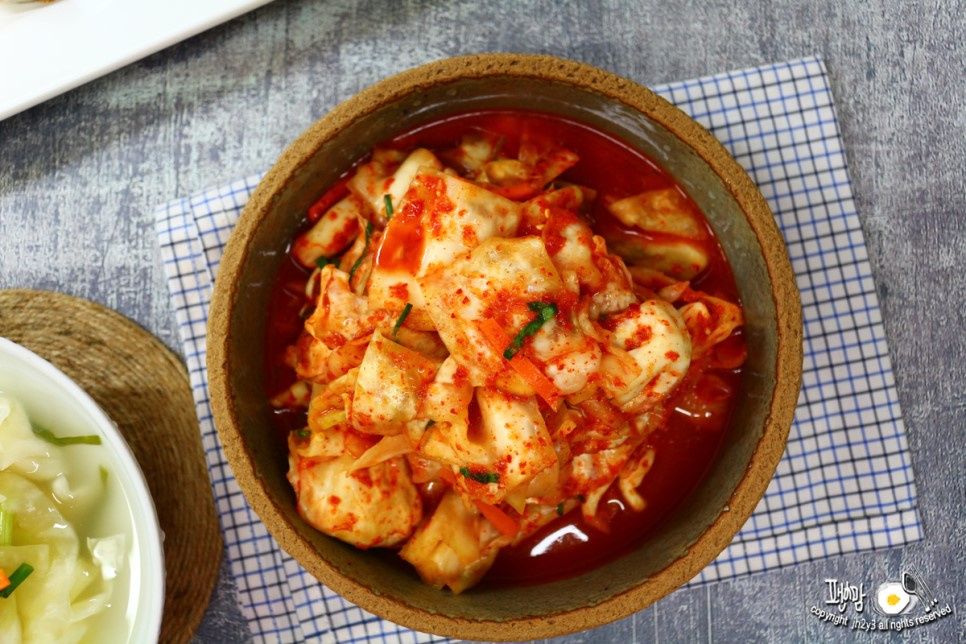Crispy and Delicious Homemade Cabbage Kimchi Recipe
Super Easy Cabbage Preparation & Delicious Cabbage Kimchi Recipe

The cabbage kimchi I made a few days ago has perfectly fermented and is now enriching our dining table. This sweet, sour, and refreshing cabbage water kimchi is a feast for the eyes and the palate. Cabbage kimchi is truly a ‘rice thief’ for its incredible taste. The crisp texture combined with its tangy flavor is such a delight that it makes you want to finish your rice in no time. Made with fiber-rich cabbage, this kimchi is easy to digest and soothes the stomach, making it a favorite for everyone.
Main Ingredients- Cabbage 8kg
Making Rice Paste (Juk)- Water 1.8L
- Rice flour (non-glutinous) 9 Tbsp
Salting the Cabbage- Water 2L
- Coarse sea salt 3 cups
Seasoning Paste Ingredients- Red chili peppers 130g
- Onion 300g
- Green onions (scallions) 150g
- Chives 50g
- Apple 1
- Garlic 200g
- Ginger 30g
- Gochugaru (Korean chili flakes) 3 cups
- Fish sauce (anchovy) 2/3 cup
- Fermented shrimp (saeujeot) 2/3 cup
- Plum extract 2/3 cup
- Salt 3 Tbsp
- New sugar 1 Tbsp
- Water 1.8L
- Rice flour (non-glutinous) 9 Tbsp
Salting the Cabbage- Water 2L
- Coarse sea salt 3 cups
Seasoning Paste Ingredients- Red chili peppers 130g
- Onion 300g
- Green onions (scallions) 150g
- Chives 50g
- Apple 1
- Garlic 200g
- Ginger 30g
- Gochugaru (Korean chili flakes) 3 cups
- Fish sauce (anchovy) 2/3 cup
- Fermented shrimp (saeujeot) 2/3 cup
- Plum extract 2/3 cup
- Salt 3 Tbsp
- New sugar 1 Tbsp
- Red chili peppers 130g
- Onion 300g
- Green onions (scallions) 150g
- Chives 50g
- Apple 1
- Garlic 200g
- Ginger 30g
- Gochugaru (Korean chili flakes) 3 cups
- Fish sauce (anchovy) 2/3 cup
- Fermented shrimp (saeujeot) 2/3 cup
- Plum extract 2/3 cup
- Salt 3 Tbsp
- New sugar 1 Tbsp
Cooking Instructions
Step 1
Start by removing the outer leaves of the cabbage. The recipe calls for 3 heads of cabbage, but I used 2 and a half heads for this kimchi. The remaining half can be used to make a separate cabbage water kimchi.

Step 2
Cut each cabbage head in half, then slice them into approximately 1.5-inch (3cm) thick pieces. Remove the tough core from each piece and cut the inner parts into similar 1.5-inch (3cm) chunks. This method makes handling the cabbage much easier.

Step 3
In a large bowl, dissolve 2 cups of coarse sea salt in 2L of water. Pour this brine over the cut cabbage and mix well. Sprinkle the remaining 1 cup of salt over the cabbage. Let it salt for about 4 hours, flipping the cabbage pieces 2-3 times in between to ensure even salting and optimal crispness.

Step 4
While the cabbage is salting, prepare the rice paste. Make a thin porridge by mixing 1.8L of water with 9 Tbsp of non-glutinous rice flour, ensuring there are no lumps, and cook until slightly thickened.

Step 5
After salting for about 4 hours, rinse the cabbage thoroughly under cold running water 3 to 4 times to remove excess salt. Drain the cabbage well in a colander. I prefer rinsing it 4 times for a cleaner taste, but 3 times is sufficient if the cabbage is clean.

Step 6
Prepare all the ingredients for the seasoning paste. Wash or peel them as needed.

Step 7
Cut the green onions and chives into approximately 2-inch (5cm) lengths. Chop the red chili peppers, apple, onion, garlic, and ginger into manageable pieces for blending. First, use the ‘cut’ function on your blender, then switch to the ‘grind’ function for a finer paste.

Step 8
In a large mixing bowl, combine the fermented shrimp (saeujeot) (2/3 cup), anchovy fish sauce (2/3 cup), and plum extract (2/3 cup).

Step 9
Add the gochugaru (3 cups), new sugar (1 Tbsp), and salt (3 Tbsp) to the bowl. Mix everything together thoroughly to create the seasoning paste.

Step 10
Incorporate the blended fruit and vegetable mixture into the seasoning paste and mix well.

Step 11
Add the drained cabbage to the well-mixed seasoning paste. Gently but firmly, mix the cabbage and paste together, ensuring every piece is evenly coated. Get into the rhythm and enjoy the process – a little bit of energetic mixing can add to the fun! (Heave ho!)

Step 12
Your delicious cabbage kimchi is ready! Pack the kimchi tightly into airtight containers. Let it sit at room temperature for about a day to allow it to begin fermenting and develop a pleasant sourness. Once you notice the tangy aroma, transfer it to the refrigerator or a kimchi refrigerator to continue fermenting and enjoy later!



